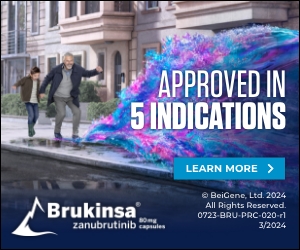
Click to Enlarge: Summary of CGC interpretation of evidence for newer diabetes medications compared with usual care or placebo.
Favors intervention (green) or favors comparator (red; not present in this figure) indicates a statistically significant difference between the intervention and comparison or a meaningful difference in effect size (i.e., ≥25% increase or decrease) with 95% CIs not crossing both lower (0.75) and upper (1.25) bounds. Italicized interpretation text indicates statistically significant findings. Statistics are from the American College of Physicians (ACP)–funded systematic review and network meta-analysis (24) available in Supplement Tables 1 to 4. Interpretation of findings was done by the CGC. CGC = Clinical Guidelines Committee; CHF = congestive heart failure; CKD = chronic kidney disease; DPP-4 = dipeptidyl peptidase-4; GLP-1 = glucagon-like peptide-1; MACE = major adverse cardiovascular events; MI = myocardial infarction; SAE = serious adverse event; SGLT-2 = sodium–glucose cotransporter-2.
* SAEs were defined by investigators, varied, and were not always fully reported. In general, these SAEs included events considered fatal or life-threatening and incorporated events (e.g., stroke, MI) that could also be a clinical benefit (through a reduction) with type 2 diabetes treatment (24). Long-acting insulins and sulfonylureas directly cause hypoglycemia and were used either as a direct comparator or within usual care, which may distort findings. Source: Annals of Internal Medicine
PORTLAND, OR — The newest medications for Type 2 diabetes have benefits beyond controlling blood sugar. Evidence suggests they also reduce mortality and the risk of cardiac events.
To guide clinicians on the appropriate use of these medications, the American College of Physicians (ACP) has released “Newer Pharmacological Treatments in Adults with Type 2 Diabetes: A Clinical Guideline from the American College of Physicians.”
The guideline, an update of ACP’s 2017 guideline, is based on the best available evidence regarding effectiveness, comparative benefits and harms, patients’ values and preferences and costs, according to a press release on the guideline.
In its 2017 guideline, the APA recommended physicians should prescribe metformin to patients with Type 2 diabetes when medication is needed to improve high blood sugar. The new guideline, published in Annals of Internal Medicine, offers recommendations for using two new drug classes—sodium-glucose cotransporter-2 (SGLT-2) inhibitors and glucagon-like peptide-1 (GLP-1) receptor agonists—as monotherapies or in combination with metformin or other therapies.1
The emergence of SGLT-2 inhibitors such as empagliflozin and GLP-1 receptor agonists such as semaglutide, along with evidence indicating these newer medications could reduce mortality and cardiovascular events—benefits not demonstrated by older classes of diabetes medications—prompted the update of the guidelines, said Adam Obley, MD, associate professor of medicine at Oregon Health & Science University and associate chief of staff for community care at VA Portland, OR, Healthcare System. Obley is one of 14 members who serve on the ACP Clinical Guidelines committee, and was among three committee members drafting and revising the guideline.
Among its recommendations, the updated clinical guideline suggests adding a SGLT-2 inhibitor or GLP-1 agonist to metformin and lifestyle interventions in patients with Type 2 diabetes and inadequate glycemic control. It also recommends using a SGLT-2 inhibitor to reduce the risk of all-cause mortality, major adverse cardiovascular events, progression of chronic kidney disease and hospitalization due to congestive heart failure or a GLP-1 agonist to reduce the risk of all-cause mortality, major adverse cardiovascular events and stroke.
ACP, however, recommends against adding a dipeptidyl peptidase-4 (DPP-4) inhibitor, an older class of medications, to metformin and lifestyle modifications in adults with Type 2 diabetes and inadequate glycemic control. The guideline panel pointed out high-certainty evidence showed that adding a DPP-4 inhibitor does not reduce morbidity or all-cause mortality.
“Those recommendations are based on a systematic review of the evidence that showed those classes of medications reduce all-cause mortality and major cardiovascular events, among other outcomes that matter to patients,” Obley explained. “The reason we consider these as add-ons to metformin is that in most of the studies, patients were already on metformin when the newer agents were added.”
APA guidelines are developed using a rigorous and widely recognized development process, Obley said. “Our recommendations follow from an in-depth systematic review of clinical evidence, economic analysis, and studies of patient values and preferences. Our guideline development follows a standard set of procedures that our committee has outlined in previous publications,” he said. “In my view, one of the key strengths of ACP’s guideline work is its stringent and transparent conflict of interest policy.”
Although the VA doesn’t have any direct role in the development of ACP guidelines, several members of the ACP Clinical Guidelines Committee—including Obley—are current or past VA clinicians, he said. “The systematic review of the evidence that was used in developing the guidelines was conducted by one of ACP’s Centers for Evidence Reviews that is based at the Minneapolis VA. No VA health records were used in developing the guideline.”
The guideline’s key message for any clinician treating diabetes is that these two new medication classes are available. “Which of those drugs to use will depend on the patient’s comorbid conditions and treatment priorities. As an example, patients with obesity and diabetes who prioritize weight loss may be better served by adding a GLP1 receptor agonist to metformin, while those with diabetes and early stage chronic kidney disease or heart failure may benefit more from adding an SGLT2 inhibitor,” Obley said.
“Overall, this represents a paradigm shift in managing diabetes—the question now isn’t merely whether treatment is achieving glycemic targets but whether patients are being prescribed medications that we know can reduce mortality, heart attacks, strokes and kidney failure,” he added.
Diabetes affects nearly 25% of the VA’s patient population. The disease is the leading cause of blindness, end-stage renal disease, and amputation for veterans treated in the VHA.
- Qaseem, A, Obley, A J, Shamliyan, T, Hicks, L A, Clinical Guidelines Committee of the American College of Physicians, et. Al. Newer Pharmacologic Treatments in Adults With Type 2 Diabetes: A Clinical Guideline From the American College of Physicians. Annals of Internal Medicine, 177(5), 658–666. https://doi.org/10.7326/M23-2788

